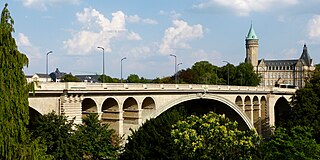 W
WThe Adolphe Bridge is a double-decked arch bridge in Luxembourg City, in southern Luxembourg. The bridge provides a one-way route for road traffic across the Pétrusse, from Boulevard Royal, in Ville Haute, to Avenue de la Liberté, in Gare. Its upper deck is 153 m in length and carries two lanes of road traffic, and two pedestrian footpaths. Its lower deck, opened in 2018, suspended beneath the upper deck, is 154 m in length, and carries a dedicated bidirectional bicycle path, with access provided for pedestrian use. As of 13 December 2020, following the completion of the second phase of the construction of the city's new tramline, the bridge carries bidirectional tram traffic on its upper deck.
 W
WBritannia Bridge is a bridge across the Menai Strait between the island of Anglesey and the mainland of Wales. It was originally designed and built by the noted railway engineer Robert Stephenson as a tubular bridge of wrought iron rectangular box-section spans for carrying rail traffic. Its importance was to form a critical link of the Chester and Holyhead Railway's route, enabling trains to directly travel between London and the port of Holyhead, thus facilitating a sea link to Dublin, Ireland.
 W
WThe Craigavon Bridge is one of three bridges in Derry, Northern Ireland. It crosses the River Foyle further south than the Foyle Bridge and Peace Bridge. It is one of only a few double-decker road bridges in Europe. It was named after Lord Craigavon, the first Prime Minister of Northern Ireland.
 W
WThe Danube Bridge is a steel truss bridge over the Danube River connecting the Bulgarian bank to the south with the Romanian bank to the north and the cities of Ruse and Giurgiu respectively. It is one of only two bridges connecting Romania and Bulgaria, the other one being the New Europe Bridge between the cities of Vidin and Calafat.
 W
WThe Dom Luís I Bridge, or Luís I Bridge, is a double-deck metal arch bridge that spans the River Douro between the cities of Porto and Vila Nova de Gaia in Portugal. At its construction, its 172 metres (564 ft) span was the longest of its type in the world. It has been confused with the nearby Maria Pia Bridge, a railway bridge that was built 9 years earlier, which is similar in aspect to the Luís I bridge.
 W
WThe Fort Pitt Bridge is a steel, double-decked bowstring arch bridge that spans the Monongahela River near its confluence with the Allegheny River in Pittsburgh, Pennsylvania. It carries Interstate 376 between the Fort Pitt Tunnel and Downtown Pittsburgh. Opened in June 1959 as a replacement for the Point Bridge, the Fort Pitt Bridge was the world's first computer-designed bowstring arch bridge and double-decked bowstring arch bridge. The bridge is known for its difficult lane changes, especially on the lower level, often requiring people to go from the extreme left lane across two lanes to the extreme right lane in only 300 feet. The upper level is more forgiving for some routes, but still requires a full span lane change in 300 feet to get from the south side entrance to the downtown exits.
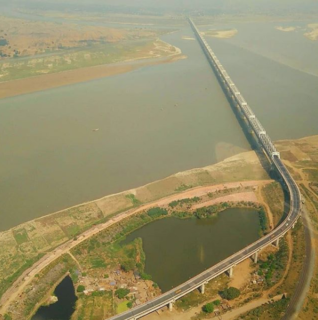 W
WThe Digha–Sonpur bridge or J.P. Setu is a rail-cum-road bridge across river Ganga, connecting Digha Ghat in Patna and Pahleja Ghat in Sonpur, Saran district in the Indian state of Bihar. It is named after Indian independence activist Jayaprakash Narayan (J.P.). The rail-cum-road bridge provides easy roadway and railway link between northern and southern parts of Bihar. It is a steel truss bridge. Regular scheduled passenger rail service was inaugurated on this route on 3 February 2016. This bridge of 4,556 metres (14,948 ft) length is the second longest rail-cum-road bridge in India, after Bogibeel Bridge in Assam.
 W
WThe George Washington Bridge is a double-decked suspension bridge spanning the Hudson River, connecting the New York City borough of Manhattan with the New Jersey borough of Fort Lee. The bridge is named after George Washington, the first president of the United States. The George Washington Bridge is the world's busiest motor vehicle bridge, carrying over 103 million vehicles in 2016. It is owned by the Port Authority of New York and New Jersey, a bi-state government agency that operates infrastructure in the Port of New York and New Jersey. The George Washington Bridge is also informally known as the GW Bridge, the GWB, the GW, or the George, and was known as the Fort Lee Bridge or Hudson River Bridge during construction.
 W
WThe Godavari Bridge or Kovvur–Rajahmundry Bridge is truss bridge spanning Godavari River in Rajahmundry, India. It is India's third longest road-cum-rail bridge crossing a water body, first one is The Bogibeel Bridge is rail-cum-road bridge over the Brahmaputra river in the Dibrugarh district of Assam state in north-east India, and second is Digha–Sonpur Bridge over Ganges in Bihar.
 W
WThe Henry Hudson Bridge is a steel arch toll bridge in New York City across the Spuyten Duyvil Creek. It connects Spuyten Duyvil in the Bronx with Inwood in Manhattan to the south, via the Henry Hudson Parkway. On the Manhattan side, the parkway goes into Inwood Hill Park. Commercial vehicles are not permitted on this bridge or on the parkway in general.
 W
WThe High Level Bridge is a road and railway bridge spanning the River Tyne between Newcastle upon Tyne and Gateshead in North East England. It is considered the most notable historical engineering work in the city. It was built by the Hawks family from 5,050 tons of iron. George Hawks, Mayor of Gateshead, drove in the last key of the structure on 7 June 1849, and the bridge was officially opened by Queen Victoria later that year.
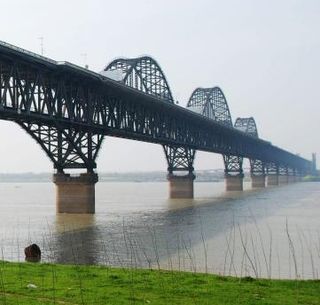 W
WThe Jiujiang Yangtze River Bridge is a combined road-rail bridge over the Yangtze River near the city of Jiujiang, Jiangxi Province in eastern China. It links Xunyang District of Jiujiang, south of the river, with Xiaochi Town in Huangmei County, Hubei Province, to the north. The central section of the bridge uses a combined arch and truss structure and the bridge is one of the longest continuous truss bridges in the world, with a longest span of 216 meters (709 ft) and a total truss length of 1,314 meters (4,311 ft) =3x162+180+216+180+2x126. The double deck bridge carries four vehicular lanes and two sidewalks on the top deck and two railway tracks on the bottom deck.
 W
WThe Kap Shui Mun Bridge (KSMB) in Hong Kong is one of the longest cable-stayed bridges in the world that transports both road and railway traffic, with the upper deck used for motor vehicles and the lower deck used for both vehicles and the MTR. It has a main span of 430 metres (1,410 ft) and an overall length of 750 metres (2,460 ft). It spans the Kap Shui Mun marine channel between Ma Wan and Lantau and has a vertical clearance of 47 metres (154 ft) above sea level. The bridge was completed in 1997.
 W
WMa Wan Viaduct is a viaduct built over Ma Wan, an island in Hong Kong. The viaduct connects the Tsing Ma Bridge and Kap Shui Mun Bridge with an exit to Ma Wan Road, and is part of the Lantau Link and Route 8. It was opened on 22 May 1997 and was built to provide access to the Hong Kong International Airport as part of the Airport Core Programme.
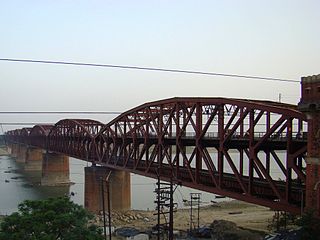 W
WMalviya Bridge, inaugurated in 1887, is a double decker bridge over the Ganges at Varanasi. It carries rail track on lower deck and road on the upper deck. It is one of the major bridges on the Ganges and carries the Grand Trunk Road across the river.
 W
WThe Manhattan Bridge is a suspension bridge that crosses the East River in New York City, connecting Lower Manhattan at Canal Street with Downtown Brooklyn at the Flatbush Avenue Extension. The main span is 1,480 ft (451 m) long, with the suspension cables being 3,224 ft (983 m) long. The bridge's total length is 6,855 ft (2,089 m). It is one of four toll-free vehicular bridges connecting Manhattan Island to Long Island; the nearby Brooklyn Bridge is just slightly further downtown, while the Queensboro and Williamsburg bridges are to the north.
 W
WThe Meridian Highway Bridge is a bridge that formerly carried U.S. Route 81 across the Missouri River between Nebraska and South Dakota. The Meridian Highway Bridge connects Yankton, South Dakota with rural Cedar County, Nebraska. The Meridian Bridge is a double deck bridge, with the top level having carried traffic into South Dakota from Nebraska, and the lower level having carried traffic into Nebraska from South Dakota.
 W
WSrikrishna Setu Munger Ganga Bridge, is a rail-cum-road bridge across the Ganges, at Munger in the Indian state of Bihar. The bridge connects Munger District Munger-Jamalpur twin cities to various districts of North Bihar. Srikrishna Setu Munger Ganga Bridge is the third rail-cum-road bridge over Ganga in Bihar.
 W
WThe Nanjing Yangtze River Bridge is a double-decked road-rail truss bridge across the Yangtze River in Nanjing, Jiangsu, connecting the city's Pukou and Gulou districts. Its upper deck is part of China National Highway 104, spanning 4,588 metres (15,052 ft). Its lower deck, with a double-track railway, is 6,772 metres (22,218 ft) long, and completes the Beijing–Shanghai railway, which had been divided by the Yangtze for decades. Its right bridge consists of nine piers, with the maximum span of 160 metres (525 ft) and the total length of 1,576 metres (5,171 ft). The bridge carries approximately 80,000 vehicles and 190 trains per day.
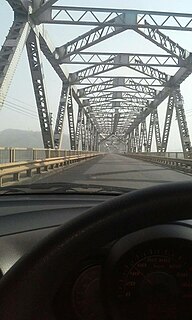 W
WNaranarayan Setu is the third bridge to have been constructed over the Brahmaputra River in Assam, India. It is a double-deck bridge with a railway track on the lower deck and a road on the upper deck. It has a length of 2.284 kilometres and connects Jogighopa, a town of Bongaigaon District on the north with Pancharatna, a town of Goalpara District on the south. The bridge was inaugurated on 15 April 1998 by Atal Bihari Vajpayee, the Prime Minister of India at that time. Construction was carried out by the consortium of The Braithwaite Burn and Jessop Construction Company Limited(BBJ).The approximate cost of construction of this bridge is Rs. 301 crore. This bridge is located on route of National Highway 17, erstwhile route NH-31B.
 W
WThe Öresund or Øresund Bridge is a combined railway and motorway bridge across the Öresund strait between Sweden and Denmark. It is the longest combined road and rail bridge in Europe, running nearly 8 kilometres from the Swedish coast to the artificial island Peberholm in the middle of the strait. The crossing is completed by the 4-kilometre (2.5 mi) Drogden Tunnel from Peberholm to the Danish island of Amager.
 W
WThe Prince Edward Viaduct System, commonly referred to as the Bloor Viaduct, is the name of a truss arch bridge system in Toronto, Ontario, Canada, connecting Bloor Street East, on the west side of the system, with Danforth Avenue on the east. The system includes the Rosedale Valley phase and the Sherbourne Phase, an embankment built to extend Bloor Street East to the Rosedale Ravine from Sherbourne Street. The Don Valley phase of the system, the most recognizable, spans the Don River Valley, crossing over the Bayview Avenue Extension, the Don River, and the Don Valley Parkway.
 W
WThe Queensboro Bridge, also known as the 59th Street Bridge – because its Manhattan end is located between 59th and 60th Streets – and officially named the Ed Koch Queensboro Bridge, is a cantilever bridge over the East River in New York City. It connects the neighborhood of Long Island City in the borough of Queens with the Upper East Side in Manhattan, passing over Roosevelt Island. The bridge was completed in 1909.
 W
WRajendra Setu is a bridge across the River Ganges that was the first bridge to link the northern and southern portions of the state of Bihar. The location of the bridge was based on the work of M. Visvesvaraya, who was more than 90 years old at the time. On wheelchair he visited bridge site on special request from the Chief Minister Dr. Shri Krishna Sinha.
 W
WThe Richmond–San Rafael Bridge is the northernmost of the east–west crossings of the San Francisco Bay in California, USA. Officially named after California State Senator John F. McCarthy, it bridges Interstate 580 from Richmond on the east to San Rafael on the west. It opened in 1956, replacing ferry service by the Richmond–San Rafael Ferry Company.
 W
WThe Rodoferroviária Rollemberg-Vuolo Bridge is a double-decker bridge over the Parana River, between the states of Mato Grosso do Sul and São Paulo in Brazil.
 W
WThe San Francisco–Oakland Bay Bridge, known locally as the Bay Bridge, is a complex of bridges spanning San Francisco Bay in California. As part of Interstate 80 and the direct road between San Francisco and Oakland, it carries about 260,000 vehicles a day on its two decks. It has one of the longest spans in the United States.
 W
WThe Sherman Minton Bridge is a double-deck through arch bridge spanning the Ohio River, carrying I-64 and US 150 over the river between Kentucky and Indiana. The bridge connects the west side of Louisville, Kentucky to downtown New Albany, Indiana.
 W
WThe Ship Canal Bridge is a double-deck steel truss bridge that carries Interstate 5 (I-5) over Seattle's Portage Bay between Capitol Hill and the University District. The canal below connects Lake Union with Lake Washington. Construction was completed in 1961 and the bridge opened to traffic on December 18, 1962. It is 4,429 ft long, stands 182 feet above the canal and is 119 feet wide at the upper deck. It was the largest bridge of its kind in the Northwest when it first opened. The bridge is double-decked, with the upper deck carrying traffic in both directions and the lower deck carrying traffic southbound in the morning and northbound in the afternoon.
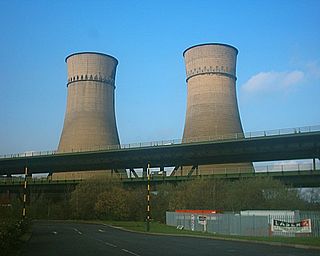 W
WTinsley Viaduct is a two-tier road bridge in Sheffield, England; it was the first of its kind in the United Kingdom. It carries the M1 and the A631 3,389 feet (1,033 m) over the Don Valley, from Tinsley to Wincobank, also crossing the Sheffield Canal, the Midland Main Line and the former South Yorkshire Railway line from Tinsley Junction to Rotherham Central. The Supertram route to Meadowhall runs below part of the viaduct on the trackbed of the South Yorkshire Railway line to Barnsley.
 W
WThe Maurice J. Tobin Memorial Bridge is a cantilever truss bridge that spans more than two miles (3 km) from Boston to Chelsea over the Mystic River in Massachusetts. The bridge is the largest in New England. It is operated by the Massachusetts Department of Transportation and carries U.S. Route 1. It was built between 1948 and 1950 and opened to traffic on February 2, 1950, replacing the former Chelsea Street Bridge. The 36-foot-wide roadway has three lanes of traffic on each of the two levels with northbound traffic on the lower level and southbound traffic on the upper level.
 W
WThe Dongshuimen Bridge and the Qianximen Bridge, known collectively as the Twin River Bridges, are a pair of bridges that form a road and rail connection in Chongqing, China. Consisting of two cable-stayed bridges and a tunnel across the Yuzhong peninsula, the connection opened in 2014.
 W
WThe Verrazzano-Narrows Bridge is a suspension bridge connecting the New York City boroughs of Staten Island and Brooklyn. It spans the Narrows, a body of water linking the relatively enclosed Upper New York Bay with Lower New York Bay and the Atlantic Ocean, and is the only fixed crossing of the Narrows. The double-deck bridge carries 13 lanes of Interstate 278, with seven lanes on the upper level and six on the lower level. The span is named for Giovanni da Verrazzano, the first documented European explorer to enter New York Harbor and the Hudson River in 1524.
 W
WThe Washington Avenue Bridge carries County Road 122 and the METRO Green Line light rail across the Mississippi River in Minneapolis and connects the East Bank and West Bank portions of the University of Minnesota campus. The bridge has two decks, with the lower deck designated for motor vehicle traffic and light rail trains and the upper deck used for pedestrians and bicycles. It is a utilitarian structure with simple architecture, but it has cultural significance because thousands of students, faculty, staff, and visitors walk across it every day.
 W
WThe Wuhan Yangtze Great Bridge, commonly known as Wuhan First Yangtze Bridge, is a double-deck road and rail bridge across the Yangtze River in Wuhan, in Central China. At its completion in 1957, the bridge was the easternmost crossing of the Yangtze, and was often referred to as the "First Bridge of the Yangtze".
 W
WThe Wuhu Yangtze River Bridge is a combined highway and railway bridge over the Yangtze river. The bridge is located in Wuhu, Anhui, China, and was completed in 2000. The cable-stayed bridge consists of a 312 metres (1,024 ft) main span and two 180 metres (591 ft) side spans and has, together with all approaches, a total length of 10,521 metres (34,518 ft). The bridges carries four lanes of the G5011 Wuhu–Hefei Expressway on the upper deck and the dual-track Huainan Railway on the lower deck.